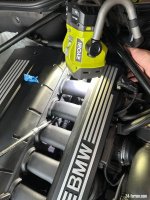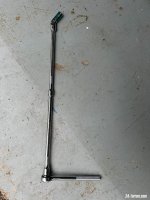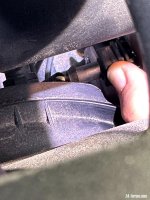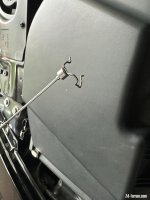lucasxdiniz
Active member
Removal: 20-60min
Installation: 15-30min
Tools you will need:
Tools you might need:
Where to buy your starter motor:
HOW TO:
A great deal of this DIY is knowing what you're trying to remove, and how to access it. So the next few images will hopefully make this clear as not many have seen a starter before.
Note that the images make reference to front, rear, and side views; these correspond to the front, rear, and side of the car respectively.
Figure 1 shows the two areas of the engine bay to which you will need partial access. Area A is where 99% of what you'll be working on is, and area B is just used to help slacken some cables, or pull the negative connector out* of Area A. Within Area A you will locate the starter motor, please see figure 2.

FIGURE 1: View from where the person working on the car would stand throughout this DIY

FIGURE 2: Starter motor location.
Now that you know where to find the starter motor, here's what it looks like and all the bolts and connectors you must undo.
Figure 3 shows the two bolts that attach the starter to the bell housing. Bolt 1, highlighted red, is a very long bolt in a relatively tight space, and it can be hard to locate as there are similar bolts all around the bell housing, so to make this 'how to' idiot proof, figure 4 should highlight its location. Bolt 2, highlighted green, is a much smaller than bolt 1, and it is easily located and easy to remove.

FIGURE 3: Starter motor rear view showing flange that's used to attach it to the bellhousing. Red = Bolt 1, Green = Bolt 2.

FIGURE 4: Bolt 1 location
There are three wires attached to the front of the starter motor, two thick red wires are bolted onto the positive terminal of the starter (see figure 5), and one thin black wire is connected to the negative terminal (see figure 5) with a plastic connector.

FIGURE 5: Start motor front view showing the electrical connectors. Blue = Pos Terminal, Yellow = Neg Terminal.
Now you should know what you're tackling, so here's a step by step that worked for me.
Step 1: Disconnect the positive terminal of your battery
Step 2: Use a flat screwdriver to remove the top cover of the air box, it's very self-explanatory. Disconnect the MAF connector. Use a 6mm socket or a small flat screwdriver to loosen the jubilee clips to remove the rest of the intake pipes/sound generator.
Step 3: Place an E14 socket onto bolt 1, then attach your (3/8") ratchet to the socket and loosen the bolt. There's not enough space to place the socket onto the bolt whilst it's attached to the ratchet. Once the bolt is loose, undo the rest by hand. It's quicker, and you don't have enough space to finish undoing it with a ratchet.
Step 4: Undo bolt 2 with an E14 socket.
Note that bolt 1 should be undone before bolt 2 so there's less load on bolt 1 and it can be undone by hand once loose.
Step 5: Pull the starter motor frontwards out of the bellhousing.
Step 6: Once it's out, manoeuvre the starter motor rearwards to create more room for your hands to reach the electrical connectors. You may need to use Area B to slacken the cables of the starter motor so you can move it more freely.
Visibility is poor for the next few steps, so use a torch and the space inbetween the plenums of the intake manifold to see what you're doing.
Step 7: The negative connector has a spring lock, use a flat screwdriver to lift it out of the connector. Remove it completely (it's fine if it falls, you will be able to retrieve it once the starter is out), then it can be pulled out from the starter motor with only one hand.
Step 8: Once that annoying connector is off, it may take you a while to do it with one hand, you will be able to put a 13mm socket in a 1/4" ratchet on the positive terminal. The end of the ratchet will need to poke out of one of the spaces inbetween the intake manifold plenums. Very little room to move the tool so undoing the nut might take a while. A 13mm ratchet spanner will not fit the nut.
Step 9: Slide the alternator/battery cable out of the bolt in the alternator. Now you should be able to remove the starter motor out of the engine bay. First bring it towards you at the same level it is placed, once you clear the engine, you should be able to bring it up.
Step 10: If your starter replacement is an identical part to the OE part, then installation is exactly the reverse of removal. If your replacement has a different negative terminal connector, then read on.
Step 11: Pull the negative/ignition cable out of the engine bay through Area B. Once you can easily work on this cable, cut the stock connector without wasting any wire length. Strip approximately 10mm of cable and place it inside the female crimp connector, use a crimping tool to crimp the connector to the wire. Wrap insulation tape around it, just leaving the very end of the connector exposed. Guide the cable back to where it should be - think you're trying to hug the intake manifold and you'll manage.
Step 12: Installation should be the opposite of removal, however, you might find it easier to install the positive wires first, being careful on how they are positioned so then the negative terminal can be connected to the male connector in the starter motor.
*Only required if the replacement starter motor has a different connector for the ignition wire.
Installation: 15-30min
Tools you will need:
- 1/4" Ratchet + Extensions
- 3/8" Ratchet
- E14 Socket
- 13mm Socket
- 6mm Socket
- Flathead Screwdriver
Tools you might need:
- T15 torx if you have a sound generator installed
- Snips of some sort to strip the negative wire*
- Crimping tool recommended, pliers would work too*
- Insulation tape*
Where to buy your starter motor:
- BMW ~£350
- ECP £80-£158 (Might vary wildly with different promo codes and some brands have a refundable surcharge)
- Autodoc.co.uk £60-100 (German company)
- West Lancs Auto Electics £96
HOW TO:
A great deal of this DIY is knowing what you're trying to remove, and how to access it. So the next few images will hopefully make this clear as not many have seen a starter before.
Note that the images make reference to front, rear, and side views; these correspond to the front, rear, and side of the car respectively.
Figure 1 shows the two areas of the engine bay to which you will need partial access. Area A is where 99% of what you'll be working on is, and area B is just used to help slacken some cables, or pull the negative connector out* of Area A. Within Area A you will locate the starter motor, please see figure 2.

FIGURE 1: View from where the person working on the car would stand throughout this DIY

FIGURE 2: Starter motor location.
Now that you know where to find the starter motor, here's what it looks like and all the bolts and connectors you must undo.
Figure 3 shows the two bolts that attach the starter to the bell housing. Bolt 1, highlighted red, is a very long bolt in a relatively tight space, and it can be hard to locate as there are similar bolts all around the bell housing, so to make this 'how to' idiot proof, figure 4 should highlight its location. Bolt 2, highlighted green, is a much smaller than bolt 1, and it is easily located and easy to remove.

FIGURE 3: Starter motor rear view showing flange that's used to attach it to the bellhousing. Red = Bolt 1, Green = Bolt 2.

FIGURE 4: Bolt 1 location
There are three wires attached to the front of the starter motor, two thick red wires are bolted onto the positive terminal of the starter (see figure 5), and one thin black wire is connected to the negative terminal (see figure 5) with a plastic connector.

FIGURE 5: Start motor front view showing the electrical connectors. Blue = Pos Terminal, Yellow = Neg Terminal.
Now you should know what you're tackling, so here's a step by step that worked for me.
Step 1: Disconnect the positive terminal of your battery
Step 2: Use a flat screwdriver to remove the top cover of the air box, it's very self-explanatory. Disconnect the MAF connector. Use a 6mm socket or a small flat screwdriver to loosen the jubilee clips to remove the rest of the intake pipes/sound generator.
Step 3: Place an E14 socket onto bolt 1, then attach your (3/8") ratchet to the socket and loosen the bolt. There's not enough space to place the socket onto the bolt whilst it's attached to the ratchet. Once the bolt is loose, undo the rest by hand. It's quicker, and you don't have enough space to finish undoing it with a ratchet.
Step 4: Undo bolt 2 with an E14 socket.
Note that bolt 1 should be undone before bolt 2 so there's less load on bolt 1 and it can be undone by hand once loose.
Step 5: Pull the starter motor frontwards out of the bellhousing.
Step 6: Once it's out, manoeuvre the starter motor rearwards to create more room for your hands to reach the electrical connectors. You may need to use Area B to slacken the cables of the starter motor so you can move it more freely.
Visibility is poor for the next few steps, so use a torch and the space inbetween the plenums of the intake manifold to see what you're doing.
Step 7: The negative connector has a spring lock, use a flat screwdriver to lift it out of the connector. Remove it completely (it's fine if it falls, you will be able to retrieve it once the starter is out), then it can be pulled out from the starter motor with only one hand.
Step 8: Once that annoying connector is off, it may take you a while to do it with one hand, you will be able to put a 13mm socket in a 1/4" ratchet on the positive terminal. The end of the ratchet will need to poke out of one of the spaces inbetween the intake manifold plenums. Very little room to move the tool so undoing the nut might take a while. A 13mm ratchet spanner will not fit the nut.
Step 9: Slide the alternator/battery cable out of the bolt in the alternator. Now you should be able to remove the starter motor out of the engine bay. First bring it towards you at the same level it is placed, once you clear the engine, you should be able to bring it up.
Step 10: If your starter replacement is an identical part to the OE part, then installation is exactly the reverse of removal. If your replacement has a different negative terminal connector, then read on.
Step 11: Pull the negative/ignition cable out of the engine bay through Area B. Once you can easily work on this cable, cut the stock connector without wasting any wire length. Strip approximately 10mm of cable and place it inside the female crimp connector, use a crimping tool to crimp the connector to the wire. Wrap insulation tape around it, just leaving the very end of the connector exposed. Guide the cable back to where it should be - think you're trying to hug the intake manifold and you'll manage.
Step 12: Installation should be the opposite of removal, however, you might find it easier to install the positive wires first, being careful on how they are positioned so then the negative terminal can be connected to the male connector in the starter motor.
*Only required if the replacement starter motor has a different connector for the ignition wire.



